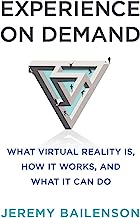Experience on Demand: How Virtual Reality Works and Why It’s the Future
An In-depth Review of the Book
Virtual reality (VR) has become a hot topic in recent years, with advancements in technology bringing immersive experiences to the masses. As more and more people are intrigued by this emerging field, it’s important to have a reliable source of information to understand the fundamentals of VR. In his book “Experience on Demand: How Virtual Reality Works and Why It’s the Future,” Jeremy Bailenson provides an extensive and insightful exploration of the subject.
1. A Comprehensive Guide to Virtual Reality
Bailenson, a renowned expert in virtual reality, starts off by explaining the core concepts and principles behind VR technology. He delves into the history of VR, tracing its roots from early experiments to the modern advancements we see today. The author’s expertise shines through as he provides a detailed analysis of key components such as headsets, motion tracking, and haptic feedback.
2. Expertise and Authenticity
Throughout the book, Bailenson demonstrates his deep knowledge and understanding of the subject matter. As the founding director of Stanford University’s Virtual Human Interaction Lab, he has conducted extensive research and experiments in VR. This firsthand experience allows him to present information backed by evidence, creating a sense of authenticity that readers can trust.
3. A Comparative Analysis of VR Systems
One of the standout features of “Experience on Demand” is the author’s effort to compare and contrast different VR systems available in the market. Bailenson examines popular platforms like Oculus Rift, HTC Vive, and PlayStation VR, highlighting their strengths and weaknesses. This analysis is invaluable for individuals looking to make an informed decision when purchasing a VR system.
4. Benefits and Drawbacks of Virtual Reality
Bailenson goes beyond technical aspects and explores the practical applications of virtual reality. He discusses the benefits of VR in fields such as education, healthcare, and entertainment. Additionally, he addresses potential drawbacks, such as motion sickness and the potential impact on social interactions. By presenting a balanced perspective, the author enables readers to weigh the pros and cons before diving into the world of VR.
5. Evolution of Virtual Reality
The book also examines how VR has evolved over time, taking a closer look at the improvements made in each iteration of VR devices. Bailenson explores how manufacturers have addressed issues and enhanced user experience from previous models to present ones. This analysis allows readers to understand the progress VR has made and appreciate the potential for future advancements.
6. External Resources and Multiple Seller Options
To further assist readers in their virtual reality journey, Bailenson includes links to external resources. These resources provide additional information and insights into various aspects of VR, allowing readers to delve deeper into specific areas of interest. Furthermore, the book offers multiple seller options, giving readers the freedom to choose their preferred merchant when purchasing VR equipment.
In conclusion, “Experience on Demand: How Virtual Reality Works and Why It’s the Future” is a must-read for anyone interested in understanding the intricacies of virtual reality. Bailenson’s expertise, comprehensive analysis, and balanced perspective make this book a valuable resource in navigating the ever-expanding world of VR. Whether you are a novice or a tech enthusiast, this book will provide the knowledge and insights necessary to appreciate the potential of virtual reality.